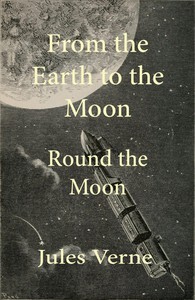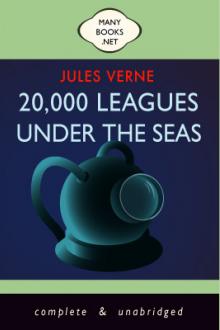The Moon-Voyage by Jules Verne (mobi ebook reader .txt) 📖

- Author: Jules Verne
Book online «The Moon-Voyage by Jules Verne (mobi ebook reader .txt) 📖». Author Jules Verne
The entrance to this tower of metal was a narrow opening in the wall of the cone, like the "man-hole" of steam boilers. It closed hermetically by means of an aluminium plate fastened inside by powerful screw pressure. The travellers could therefore leave their mobile prison at will as soon as they had reached the Queen of Night.
But going was not everything; it was necessary to see on the road. Nothing was easier. In fact, under the wadding were four thick lenticular footlights, two let into the circular wall of the projectile, the third in its lower part, and the fourth in its cone. The travellers could, therefore, observe during their journey the earth they were leaving, the moon they were approaching, and the constellated spaces of the sky. These skylights were protected against the shocks of departure by plates let into solid grooves, which it was easy to move by unscrewing them. By that means the air contained in the projectile could not escape, and it was possible to make observations.
All these mechanical appliances, admirably set, worked with the greatest ease, and the engineers had not shown themselves less intelligent in the arrangement of the projectile compartment.
Lockers solidly fastened were destined to contain the water and provisions necessary for the three travellers; they could even procure themselves fire and light by means of gas stored up in a special case under a pressure of several atmospheres. All they had to do was to turn a tap, and the gas would light and warm this comfortable vehicle for six days. It will be seen that none of the things essential to life, or even to comfort, were wanting. More, thanks to the instincts of Michel Ardan, the agreeable was joined to the useful under the form of objects of art; he would have made a veritable artist's studio of his projectile if room had not been wanting. It would be mistaken to suppose that three persons would be restricted for space in that metal tower. It had a surface of 54 square feet, and was nearly 10 feet high, and allowed its occupiers a certain liberty of movement. They would not have been so much at their ease in the most comfortable railway compartment of the United States.
The question of provisions and lighting having been solved, there remained the question of air. It was evident that the air confined in the projectile would not be sufficient for the travellers' respiration for four days; each man, in fact, consumes in one hour all the oxygen contained in 100 litres of air. Barbicane, his two companions, and two dogs that he meant to take, would consume every twenty-four hours 2,400 litres of oxygen, or a weight equal to 7 lbs. The air in the projectile must, therefore, be renewed. How? By a very simple method, that of Messrs. Reiset and Regnault, indicated by Michel Ardan during the discussion of the meeting.
It is known that the air is composed principally of twenty-one parts of oxygen and seventy-nine parts of azote. Now what happens in the act of respiration? A very simple phenomenon, Man absorbs the oxygen of the air, eminently adapted for sustaining life, and throws out the azote intact. The air breathed out has lost nearly five per cent, of its oxygen, and then contains a nearly equal volume of carbonic acid, the definitive product of the combustion of the elements of the blood by the oxygen breathed in it. It happens, therefore, that in a confined space and after a certain time all the oxygen of the air is replaced by carbonic acid, an essentially deleterious gas.
The question was then reduced to this, the azote being conserved intact—1. To remake the oxygen absorbed; 2. To destroy the carbonic acid breathed out. Nothing easier to do by means of chlorate of potash and caustic potash. The former is a salt which appears under the form of white crystals; when heated to a temperature of 400° it is transformed into chlorine of potassium, and the oxygen which it contains is given off freely. Now 18 lbs. of chlorate of potash give 7 lbs of oxygen—that is to say, the quantity necessary to the travellers for twenty-four hours.
As to caustic potash, it has a great affinity for carbonic acid mixed in air, and it is sufficient to shake it in order for it to seize upon the acid and form bicarbonate of potash. So much for the absorption of carbonic acid.
By combining these two methods they were certain of giving back to vitiated air all its life-giving qualities. The two chemists, Messrs. Reiset and Regnault, had made the experiment with success.
But it must be said the experiment had only been made in anima vili. Whatever its scientific accuracy might be, no one knew how man could bear it.
Such was the observation made at the meeting where this grave question was discussed. Michel Ardan meant to leave no doubt about the possibility of living by means of this artificial air, and he offered to make the trial before the departure.
But the honour of putting it to the proof was energetically claimed by
J.T. Maston.
"As I am not going with you," said the brave artilleryman, "the least I can do will be to live in the projectile for a week."
It would have been ungracious to refuse him. His wish was complied with. A sufficient quantity of chlorate of potash and caustic potash was placed at his disposition, with provisions for a week; then having shaken hands with his friends, on the 12th of November at 6 a.m., after having expressly recommended them not to open his prison before the 20th at 6 p.m., he crept into the projectile, the iron plate of which was hermetically shut.
What happened during that week? It was impossible to ascertain. The thickness of the projectile's walls prevented any interior noise from reaching the outside.
On the 20th of November, at six o'clock precisely, the plate was removed; the friends of J.T. Maston were rather uneasy. But they were promptly reassured by hearing a joyful voice shouting a formidable hurrah!
The secretary of the Gun Club appeared on the summit of the cone in a triumphant attitude.
He had grown fat!
CHAPTER XXIV. THE TELESCOPE OF THE ROCKY MOUNTAINS.On the 20th of October of the preceding year, after the subscription list was closed, the president of the Gun Club had credited the Cambridge Observatory with the sums necessary for the construction of a vast optical instrument. This telescope was to be powerful enough to render visible on the surface of the moon an object being at least nine feet wide.
There is an important difference between a field-glass and a telescope, which it is well to recall here. A field-glass is composed of a tube which carries at its upper extremity a convex glass called an object-glass, and at its lower extremity a second glass called ocular, to which the eye of the observer is applied. The rays from the luminous object traverse the first glass, and by refraction form an image upside down at its focus. This image is looked at with the ocular, which magnifies it. The tube of the field-glass is, therefore, closed at each extremity by the object and the ocular glasses.
The telescope, on the contrary, is open at its upper extremity. The rays from the object observed penetrate freely into it, and strike a concave metallic mirror—that is to say, they are focussed. From thence their reflected rays meet with a little mirror, which sends them back to the ocular in such a way as to magnify the image produced.
Thus in field-glasses refraction plays the principal part, and reflection does in the telescope. Hence the name of refractors given to the former, and reflectors given to the latter. All the difficulty in the execution of these optical instruments lies in the making of the object-glass, whether they be made of glass or metallic mirrors.
Still at the epoch when the Gun Club made its great experiment these instruments were singularly perfected and gave magnificent results. The time was far distant when Galileo observed the stars with his poor glass, which magnified seven times at the most. Since the 16th century optical instruments had widened and lengthened in considerable proportions, and they allowed the stellar spaces to be gauged to a depth unknown before. Amongst the refracting instruments at work at that period were the glass of the Poulkowa Observatory in Russia, the object-glass of which measured 15 inches in width, that of the French optician Lerebours, furnished with an object-glass equally large, and lastly that of the Cambridge Observatory, furnished with an object-glass 19 inches in diameter.
Amongst telescopes, two were known of remarkable power and gigantic dimensions. The first, constructed by Herschel, was 36 feet in length, and had an object-glass of 4 feet 6 inches; it magnified 6,000 times; the second, raised in Ireland, at Birrcastle, in Parsonstown Park, belonged to Lord Rosse; the length of its tube was 48 feet and the width of its mirror 6 feet; it magnified 6,400 times, and it had required an immense erection of masonry on which to place the apparatus necessary for working the instrument, which weighed 12-1/2 tons.
But it will be seen that notwithstanding these colossal dimensions the magnifying power obtained did not exceed 6,000 times in round numbers; now that power would only bring the moon within 39 miles, and would only allow objects 60 feet in diameter to be perceived unless these objects were very elongated.
Now in space they had to deal with a projectile 9 feet wide and 15 long, so the moon had to be brought within five miles at least, and for that a magnifying power of 48,000 times was necessary.
Such was the problem propounded to the Cambridge Observatory. They were not to be stopped by financial difficulties, so there only remained material difficulties.
First of all they had to choose between telescopes and field-glasses. The latter had some advantages. With equal object-glasses they have a greater magnifying power, because the luminous rays that traverse the glasses lose less by absorption than the reflection on the metallic mirror of telescopes; but the thickness that can be given to glass is limited, for too thick it does not allow the luminous rays to pass. Besides, the construction of these vast glasses is excessively difficult, and demands a considerable time, measured by years.
Therefore, although images are better given by glasses, an inappreciable advantage when the question is to observe the moon, the light of which is simply reflected they decided to employ the telescope, which is prompter in execution and is capable of a greater magnifying power; only as the luminous rays lose much of their intensity by traversing the atmosphere, the Gun Club resolved to set up the instrument on one of the highest mountains of the Union, which would diminish the depth of the aërial strata.
In telescopes it has been seen that the glass placed at the observer's eye produces the magnifying power, and the object-glass which bears this power the best is the one that has the largest diameter and the greatest focal distance. In order to magnify 48,000 times it must be much larger than those of Herschel and Lord Rosse. There lay the difficulty, for the casting of these mirrors is a very delicate operation.
Happily, some years before a savant of the Institut de France, Léon Foucault, had just invented means by which the polishing of object-glasses became very prompt and easy by replacing the metallic mirror by taking a piece of glass the size required and plating it.
It was to be fixed according to the method invented by Herschel for telescopes. In the great instrument of the astronomer at Slough, the image of objects reflected by the mirror inclined at the bottom of the tube was formed at the other extremity where the eyeglass was placed. Thus the observer, instead of being placed at the lower end of the tube, was hoisted to the upper end, and there with his eyeglass he looked down into the enormous cylinder. This combination had the advantage of doing away with the little mirror destined to send back the image to the ocular glass, which thus only reflected once instead of twice; therefore there were fewer luminous rays extinguished, the image was less feeble, and more light was obtained, a precious advantage in the observation that was to be made.
This being resolved upon, the work was begun. According to the calculations of the Cambridge Observatory staff, the tube of the new reflector was to be 280 feet long and its mirror
 Have you ever thought about what fiction is? Probably, such a question may seem surprising: and so everything is clear. Every person throughout his life has to repeatedly create the works he needs for specific purposes - statements, autobiographies, dictations - using not gypsum or clay, not musical notes, not paints, but just a word. At the same time, almost every person will be very surprised if he is told that he thereby created a work of fiction, which is very different from visual art, music and sculpture making. However, everyone understands that a student's essay or dictation is fundamentally different from novels, short stories, news that are created by professional writers. In the works of professionals there is the most important difference - excogitation. But, oddly enough, in a school literature course, you don’t realize the full power of fiction. So using our website in your free time discover fiction for yourself.
Have you ever thought about what fiction is? Probably, such a question may seem surprising: and so everything is clear. Every person throughout his life has to repeatedly create the works he needs for specific purposes - statements, autobiographies, dictations - using not gypsum or clay, not musical notes, not paints, but just a word. At the same time, almost every person will be very surprised if he is told that he thereby created a work of fiction, which is very different from visual art, music and sculpture making. However, everyone understands that a student's essay or dictation is fundamentally different from novels, short stories, news that are created by professional writers. In the works of professionals there is the most important difference - excogitation. But, oddly enough, in a school literature course, you don’t realize the full power of fiction. So using our website in your free time discover fiction for yourself. 




Comments (0)